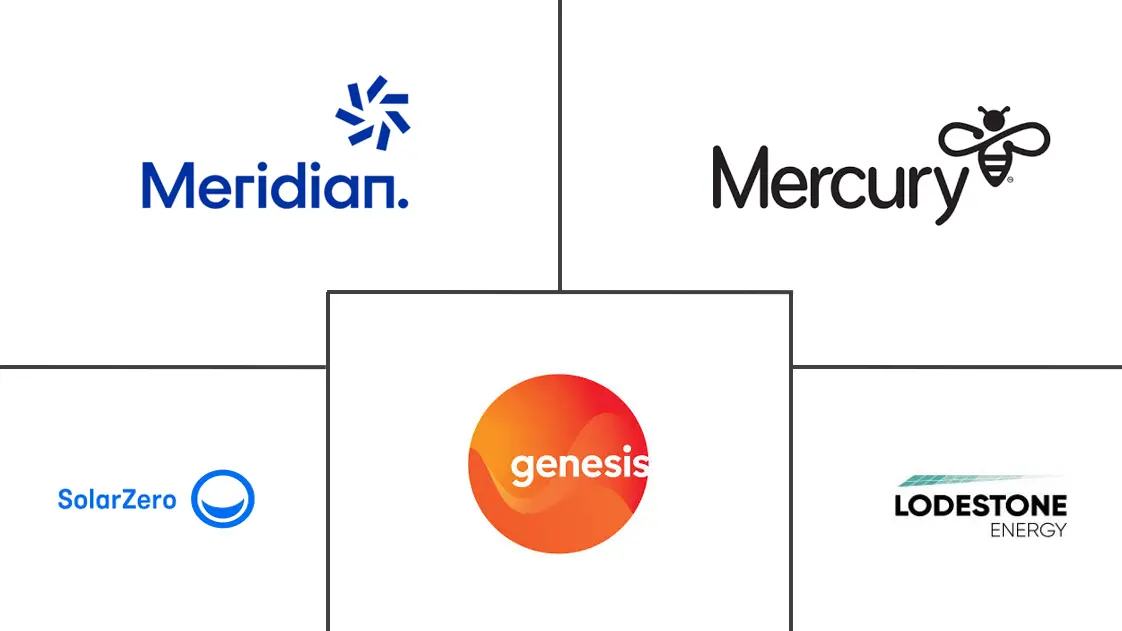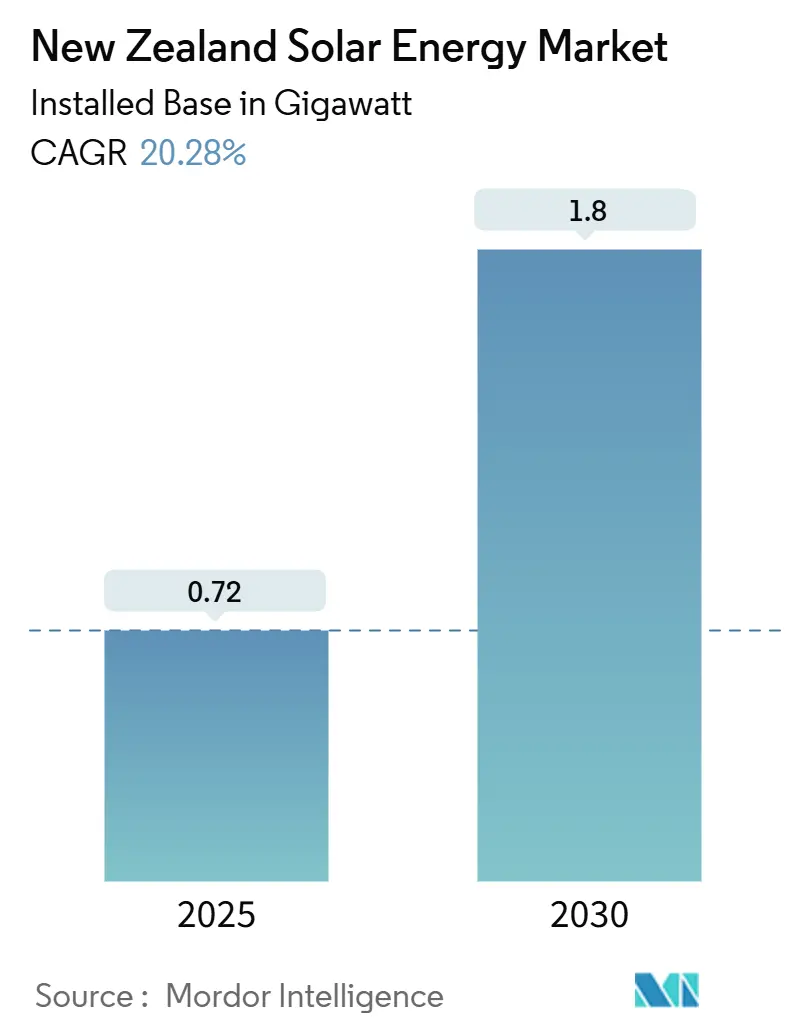
New Zealand Solar Energy Market Analysis by Mordor Intelligence
The New Zealand Solar Energy Market size in terms of installed base is expected to grow from 0.72 gigawatt in 2025 to 1.8 gigawatt by 2030, at a CAGR of 20.28% during the forecast period (2025-2030).
Falling levelised generation costs, escalating corporate renewable procurement, and accelerated grid-modernization programs are repositioning solar photovoltaic (PV) technology as a central pillar of the country’s energy transition. Investment momentum signals a structural shift away from the hydro-dominated legacy mix toward a diversified portfolio in which solar capacity is projected to triple within the period. Data-center power-purchase agreements (PPAs), led by Microsoft’s NZD 4.3 billion (USD 2.6 billion) cloud investment, are reshaping demand profiles while stimulating utility-scale build-outs.[1]Microsoft Corporation, “Cloud Infrastructure Sustainability Commitments,” microsoft.com Meanwhile, nationwide smart-meter penetration supports granular settlement, which raises returns for distributed generation, and the Transpower Renewable Energy Zone (REZ) framework reduces grid connection risk for clustered projects.[2]Transpower New Zealand, “Renewable Energy Zone Consultation,” transpower.co.nz Overall, on-grid installations dominate, but robust off-grid growth highlights the market’s widening application spectrum.
Key Report Takeaways
- By technology, solar PV held 100% of the New Zealand solar energy market share in 2024 and is projected to grow at a 20.2% CAGR through 2030.
- By connection type, on-grid systems led the New Zealand solar energy market with 97.8% of the market size in 2024, while off-grid installations are expected to record the fastest growth, at a 22.7% CAGR, to 2030.
- By end user, residential rooftops commanded 60.5% of the New Zealand solar energy market in 2024; utility-scale projects are forecast to expand at a 22.4% CAGR to 2030.
New Zealand Solar Energy Market Trends and Insights
Drivers Impact Analysis
| Driver | (~) % Impact on CAGR Forecast | Geographic Relevance | Impact Timeline |
|---|---|---|---|
| Rapid decline in levelised cost of solar electricity | +4.2% | National with emphasis on Auckland and Canterbury | Short term (≤ 2 years) |
| Corporate-PPA boom from data centers & hyperscalers | +3.8% | Concentrated in the North Island with spillover to the South Island | Medium term (2-4 years) |
| Smart-meter roll-out enabling half-hour settlement | +2.1% | National roll-out with urban priority areas | Medium term (2-4 years) |
| Emerging solar-plus-agrivoltaics pilots on dairy farms | +1.4% | Canterbury, Waikato, Taranaki dairy regions | Long term (≥ 4 years) |
| Transpower Renewable-Energy-Zone model | +2.9% | Designated zones across both islands | Long term (≥ 4 years) |
| Source: Mordor Intelligence | |||
Rapid Decline in Levelised Cost of Solar Electricity
The levelised cost of electricity for PV systems fell to NZD 0.08–0.12 per kWh (USD 0.048-0.072) in 2024, matching wholesale spot prices for the first time. Gains stem from global scale economies and module efficiencies topping 22%, creating viable economics across residential and commercial segments. Solar-leasing programs, such as solarZero’s service model, lower upfront costs and raise adoption. As storage prices soften, self-consumption rates improve, reinforcing competitiveness against hydro-peaking imports during dry years. The trajectory supports sustained cost leadership over fossil peakers.
Corporate-PPA Boom from Data Centers & Hyperscalers
Microsoft’s long-term renewable PPA with Meridian Energy anchors a surge of hyperscale procurement commitments. AWS and Google Cloud are evaluating similar arrangements, offering 15-20-year revenue stability for solar developers while providing corporations cost certainty. These bilateral contracts reduce merchant risk, catalyze financing, and reallocate generation away from spot exposure. Utility-scale projects linked to PPAs are therefore rising as prime growth vehicles.
Smart-Meter Roll-Out Enabling Half-Hour Settlement
Advanced metering now covers 87% of households, enabling half-hourly settlement that rewards flexible distributed resources. Solar owners can arbitrage peak-evening prices through paired batteries, boosting project internal rates of return up to 18% beyond simple net-metering cases. Vector’s analytics show how granular pricing signals encourage load shifting and virtual power plant aggregation, strengthening the economics of rooftop PV.
Emerging Solar-Plus-Agrivoltaics Pilots on Dairy Farms
Pilots in Canterbury and Waikato demonstrate the dual use of land, where elevated arrays lower evapotranspiration by 15-20% and yield 800-1,200 kWh per kW annually.[3]AgResearch, “Agrivoltaics Dairy Farm Trials 2024,” agresearch.co.nz Early data suggest that shading can extend grazing seasons and mitigate livestock heat stress, aligning with dairy methane reduction targets. Commercial roll-out depends on tailored finance and streamlined consents, yet pilot success signals promising co-benefits in rural regions.
Restraints Impact Analysis
| Restraint | (~) % Impact on CAGR Forecast | Geographic Relevance | Impact Timeline |
|---|---|---|---|
| Distribution-network hosting-capacity constraints | -2.7% | Auckland, Wellington, Christchurch urban zones | Short term (≤ 2 years) |
| Lengthy resource-consent process under the RMA | -1.8% | National with heightened impact in sensitive districts | Medium term (2-4 years) |
| Limited domestic PV-trained workforce | -1.2% | Nationwide shortages, acute in rural areas | Medium term (2-4 years) |
| Source: Mordor Intelligence | |||
Distribution-Network Hosting-Capacity Constraints
Auckland’s Vector and Christchurch’s Orion networks have imposed moratoriums where rooftop penetration saturates local transformers, causing voltage violations. Reinforcement and smart-inverter retrofits require up to 24 months, which can slow approvals for new residential systems. Hosting-capacity maps and dynamic operating envelopes are under trial, but near-term bottlenecks persist.
Lengthy Resource-Consent Process Under the RMA
Utility-scale projects typically face approval periods of 12-18 months, which can extend beyond three years if appeals are filed.[4]Ministry for the Environment, “RMA Consenting Statistics 2024,” mfe.govt.nz Fast-track legislation enacted in 2024 shortens timelines for designated projects, yet procedural complexity remains, especially on high-value agricultural land. Smaller developers, lacking deep legal resources, perceive an elevated risk, which dampens pipeline diversity.
Segment Analysis
By Technology: Solar PV Dominance Reflects Resource Constraints
Solar PV holds 100% share of the New Zealand solar energy market in 2024 and advances at a 20.2% CAGR through 2030. Crystalline-silicon modules account for 85% of the built capacity, with mono-PERC arrays gaining traction due to their higher power density and aesthetic appeal. The New Zealand solar energy market size for PV projects is expected to rise in tandem with Transpower’s REZ build-out, while concentrated solar power remains underutilized due to high diffuse radiation levels.
Perovskite-silicon tandem cells, forecasted to reach over 30% efficiency by 2028, could accelerate repowering cycles and enhance urban yield potential. Thin-film solutions retain niche positions in building-integrated contexts where flexibility and partial shading tolerance offset lower module efficiency. Technological learning rates ensure PV’s continued cost decline and sustained market leadership.
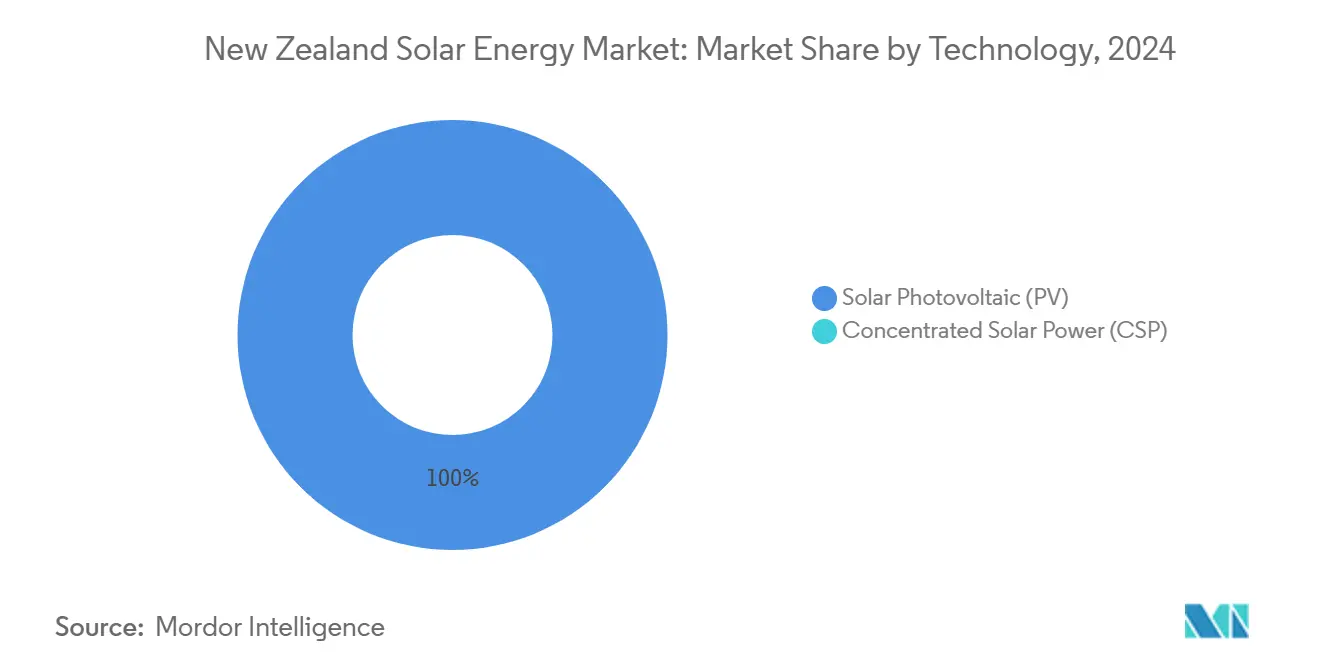
Note: Segment shares of all individual segments available upon report purchase
By Connection Type: Off-Grid Acceleration Despite On-Grid Dominance
On-grid systems controlled 97.8% of the New Zealand solar energy market share in 2024, underpinned by net metering policies and an extensive network reach. Grid-tied arrays exhibit 15-20% higher capacity factors compared to standalone systems, owing to optimized inverter loading and zero battery cycling losses.
Off-grid deployment, although accounting for only 2.2% of the New Zealand solar energy market size, is growing at a 22.7% CAGR. Remote farms, telecom relays, and micro-grids adopt hybrid PV-battery units where line extensions cost more than NZD 50,000 per km. Falling storage prices and resilience requirements strengthen the business case even as grid connections dominate aggregate capacity.
By End User: Utility-Scale Momentum Challenges Residential Leadership
The residential category retained 60.5% of 2024 installations, driven by rebates, seven- to ten-year payback periods, and solar-as-a-service contracts. Typical systems average 5 kW and leverage smart-meter settlement to monetize peak exports.
Utility-scale assets, driven by hyperscale PPAs, are projected to accelerate at a 22.4% CAGR, outpacing all other segments. Projects such as Meridian’s 130 MW Ruakākā and Genesis Energy’s 63 MW Canterbury installations demonstrate economies of scale and grid service capability. Commercial & industrial rooftops continue steady growth as demand-charge abatement and ESG reporting drive behind-the-meter adoption.
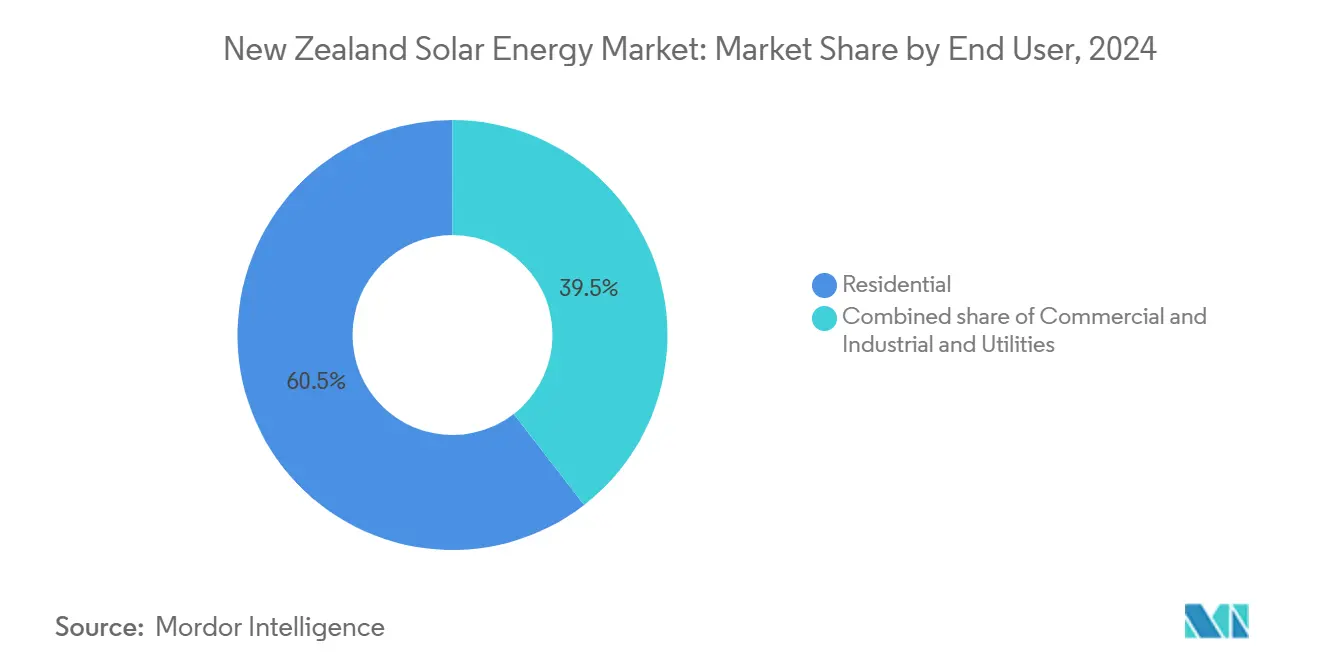
Note: Segment shares of all individual segments available upon report purchase
Geography Analysis
The North Island hosts approximately 70% of the cumulative PV capacity, led by Auckland’s 180 MW distributed base, which draws on an annual irradiance of 1,650–1,750 kWh/m². The regional New Zealand solar energy market size expands under data-center demand but faces hosting-capacity constraints that saturate urban feeders. Transpower’s REZ planning prioritizes additional bulk supply points to alleviate congestion.
Canterbury stands out as the South Island’s rising hub, enjoying 1,800+ kWh/m² irradiance and abundant flat land. The province is forecast to capture 35-40% of new utility-scale capacity additions to 2030, supported by agrivoltaics pilots and streamlined consents. Large dairy operations integrate elevated arrays that protect pasture moisture while supplying on-site loads, illustrating dual-benefit models.
Otago and Hawke’s Bay are secondary growth nodes owing to robust solar resources and proximity to high-demand horticultural processing. The West Coast and Southland lag behind due to persistent cloud cover and sparse population, although niche off-grid tourism and aquaculture projects are emerging to serve isolated sites. Overall, geographic deployment reflects resource-load alignment and grid-capacity availability, with the New Zealand solar energy market continuing its north-south diffusion trend.
Competitive Landscape
The industry is moderately fragmented, yet consolidation accelerates as incumbents pursue vertical integration. Meridian Energy, Mercury NZ, and Genesis Energy leverage balance-sheet strength to develop, own, and retail solar power, capturing full value-chain margins. Specialized firms such as solarZero and Lodestone Energy compete through service innovation, offering leasing plans and agrivoltaics concepts that address niche customer needs.
Hardware differentiation is limited because most installers source from global tier-1 suppliers, including JinkoSolar, Trina Solar, and Canadian Solar. Consequently, competition pivots toward financing creativity, digital monitoring platforms, and bundled storage. Emerging aggregators assemble distributed PV and batteries into virtual power plants that sell reserve services, signaling a pivot toward platform-based revenue models. Utilities respond by acquiring installer networks and investing in customer-side analytics to protect downstream relationships.
Mergers, joint ventures, and corporate PPAs drive intensifying market concentration. Contact Energy’s partnership with Lightsource bp on the 400 MW Te Rahui project exemplifies how local and international alliances accelerate scale and capital access. Workforce-training initiatives launched by the Solar Energy Association of New Zealand address installer shortages, supporting execution capacity amid the sector’s rapid growth.
New Zealand Solar Energy Industry Leaders
Meridian Energy Ltd
Mercury NZ Ltd
solarZero Ltd
Lodestone Energy Ltd
Genesis Energy Ltd
- *Disclaimer: Major Players sorted in no particular order
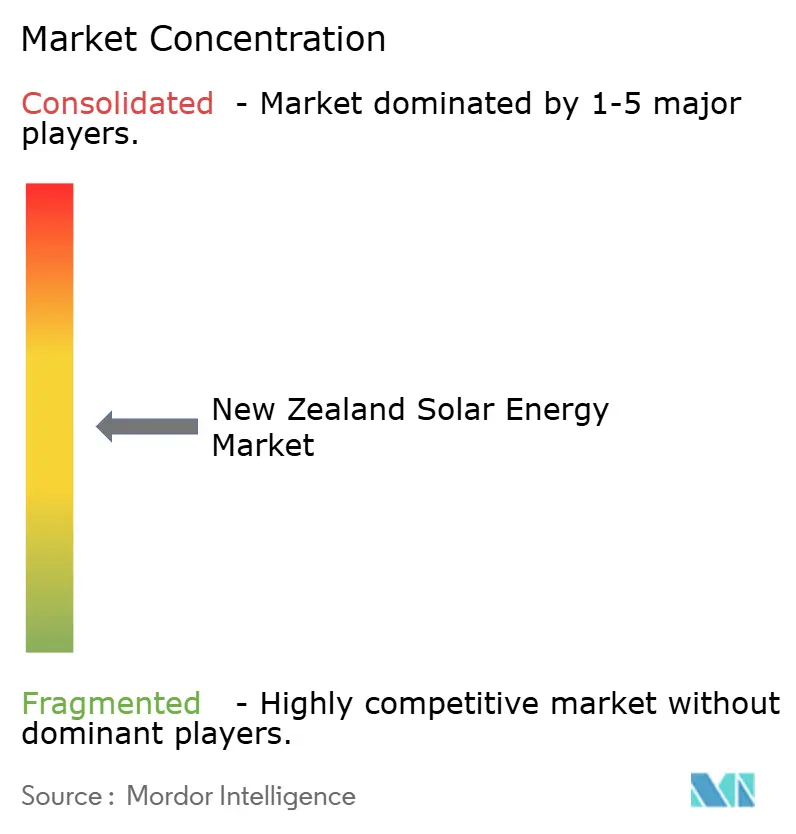
Recent Industry Developments
- September 2025: Meridian Energy and Nova Energy have inked a deal to form a joint venture (JV) aimed at building and operating the 400MW Te Rahui solar farm, located at Rangitāiki, near Taupō, New Zealand.
- May 2025: Meridian Energy has officially inaugurated New Zealand's first large-scale grid battery storage system, the Ruakākā Battery Energy Storage System (BESS). With the BESS now operational, Meridian is shifting its attention to the adjacent Ruakākā Solar Farm, a USD 227 million project boasting a capacity of 130MW.
- April 2025: Genesis, in partnership with FRV Australia, has proudly announced the completion of a 63 MW solar farm, situated just an hour's drive from Christchurch. Spanning 93 hectares, the site features over 90,000 solar panels, collectively generating an impressive 100 gigawatt-hours (GWh) of electricity annually—enough to power nearly 13,000 households.
- August 2024: Christchurch Airport broke ground on a 162 MW airfield-adjacent solar project. With a capacity of around 300,000 solar panels, the facility was projected to produce sufficient renewable energy to power nearly 36,000 homes.
New Zealand Solar Energy Market Report Scope
Solar energy is one of the renewable energies. It is made by converting the energy that is already in the sun.Once the sunlight passes through the earth's atmosphere, most of it is in the form of visible light and infrared radiation. Solar cell panels are used to convert this energy into electricity.
The New Zealand solar energy market is segmented by end-user. By end-user, the market is segmented into residential, commercial and industrial (C&I), and utility. The New Zealand solar energy market covers the size of the market and forecasts for the market. For each segment, market sizing and forecasts have been done based on installed capacity (MW).
| Solar Photovoltaic (PV) |
| Concentrated Solar Power (CSP) |
| On-Grid |
| Off-Grid |
| Residential |
| Commercial and Industrial |
| Utilities |
| By Technology | Solar Photovoltaic (PV) |
| Concentrated Solar Power (CSP) | |
| By Connection Type | On-Grid |
| Off-Grid | |
| By End-User | Residential |
| Commercial and Industrial | |
| Utilities |
Key Questions Answered in the Report
How fast is solar capacity growing in New Zealand?
Installed PV is forecast to triple from 715 MW in 2025 to 1,800 MW by 2030, equating to a 20.28% CAGR.
Which region will add the most new solar projects by 2030?
Canterbury is expected to host 35-40% of upcoming utility-scale additions, leveraging high irradiance and REZ-enabled grid access.
What share of installations are on-grid versus off-grid?
On-grid arrays held 97.8% share in 2024, although off-grid systems are expanding at a 22.7% CAGR from a small base.
Who are the leading companies in large-scale solar?
Meridian Energy, Mercury NZ, Genesis Energy, and Contact Energy headline utility-scale development, often partnering with international PV specialists.
What policy change most benefits residential adopters?
The nationwide smart-meter roll-out allows half-hourly settlement, lifting rooftop solar returns by up to 18% compared with simple net metering.
